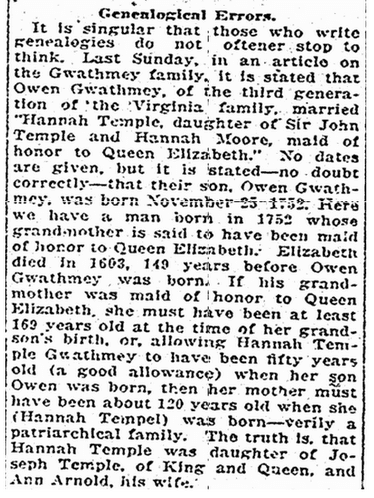How to Spot and Avoid 9 Common Genealogy Mistakes & Errors
Introduction: Mary Harrell-Sesniak is a genealogist,
author and editor with a strong technology background. In this guest
blog post, Mary discusses 9 common mistakes made when doing family history research, and suggests ways to avoid them.
Genealogical mistakes are not often easy to sort out, so let’s discuss some strategies.
1. Abbreviations Are Not Always What They Seem
Two of my favorites are “NA” and “NMI.”
In the case of the first abbreviation, “NA” might indicate non applicable, naturalized, Native American or even Navy, demonstrating the importance of finding the “key” explaining what an abbreviation actually means.
Another abbreviation that sometimes causes confusion is the use of “NMI” in place of a middle name. It is not an actual moniker, but rather used to indicate that a person has no middle initial—no middle name.
2. Age-Related Mistakes
If a woman continued to give birth through her 40s, then it is possible that a report of her having a child as an older woman may be correct.
However, whenever you see such an older mother-child relationship claim, examine the possibility that the family may have been raising an orphan or a grandchild.
For example, the American Civil War occurred between 1861 and 1865.
To view the rest of this article click on the link provided.
By Gena Philibert-Ortega for publishing it on Genealogy Bank.
"Family
history researchers are often frustrated by the mistakes of
others—particularly when there is an obvious error in identity, such as
the mistake explained in this 1914 Virginia newspaper article. It points
out that a member of the Gwathmey family was incorrectly identified as
having been a maid of honor to Queen Elizabeth.
This
sounds like an obvious mistake, and one that could have been corrected
with simple subtraction. Unfortunately, once a mistake is written in a
book or newspaper article, the mistake is often carried into other
research—forever frustrating the more serious genealogists.Genealogical mistakes are not often easy to sort out, so let’s discuss some strategies.
1. Abbreviations Are Not Always What They Seem
Two of my favorites are “NA” and “NMI.”
In the case of the first abbreviation, “NA” might indicate non applicable, naturalized, Native American or even Navy, demonstrating the importance of finding the “key” explaining what an abbreviation actually means.
Another abbreviation that sometimes causes confusion is the use of “NMI” in place of a middle name. It is not an actual moniker, but rather used to indicate that a person has no middle initial—no middle name.
2. Age-Related Mistakes
- Women who are too old to be mothers.
If a woman continued to give birth through her 40s, then it is possible that a report of her having a child as an older woman may be correct.
However, whenever you see such an older mother-child relationship claim, examine the possibility that the family may have been raising an orphan or a grandchild.
- Persons who were born too young or old to have served during a military event.
For example, the American Civil War occurred between 1861 and 1865.
Although
there are examples of very young veterans, most of the younger set did
not serve in a military capacity—unless they were older. One exception
was Civil War Missouri veteran George Huffman, who enrolled as a
volunteer in the 13th Missouri Infantry on 4 November 1861 at the age of
14. He re-enlisted on 8 February 1864, and was considered to have been
the youngest veteran to have re-enlisted that year—as explained in this
1864 Massachusetts newspaper article.
For
the most part, however, it is safe to assume that someone—other than a
drummer or bugler—must have been at least 15 when he enlisted for combat
service. Therefore, it is unlikely that a combat veteran actually
served in the Civil War if he was born after the year 1850.
Now,
if a child served in a non-military capacity, then you might find
evidence of children as young as seven involved in a war—such as Nathan
Futrell, a young boy who served in the American Revolutionary War.
You can also apply an age factor to determine the likelihood of an older person serving in the military.To view the rest of this article click on the link provided.
By Gena Philibert-Ortega for publishing it on Genealogy Bank.





No comments:
Post a Comment